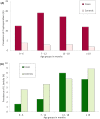Prevalence of Cryptosporidium parvum/hominis, Entamoeba histolytica and Giardia lamblia among Young Children with and without Diarrhea in Dar es Salaam, Tanzania
- PMID: 26452235
- PMCID: PMC4599730
- DOI: 10.1371/journal.pntd.0004125
Prevalence of Cryptosporidium parvum/hominis, Entamoeba histolytica and Giardia lamblia among Young Children with and without Diarrhea in Dar es Salaam, Tanzania
Abstract
Background: Although enteroparasites are common causes of diarrheal illness, few studies have been performed among children in Tanzania. This study aimed to investigate the prevalence of Cryptosporidium parvum/hominis, Entamoeba histolytica and Giardia lamblia among young children in Dar es Salaam, Tanzania, and identify risk factors for infection.
Methodology/principal findings: We performed an unmatched case-control study among children < 2 years of age in Dar es Salaam, recruited from August 2010 to July 2011. Detection and identification of protozoans were done by PCR techniques on DNA from stool specimens from 701 cases of children admitted due to diarrhea at the three study hospitals, and 558 controls of children with no history of diarrhea during the last month prior to enrollment. The prevalence of C. parvum/hominis was 10.4% (84.7% C. hominis), and that of G. lamblia 4.6%. E. histolytica was not detected. The prevalence of Cryptosporidium was significantly higher in cases (16.3%) than in controls (3.1%; P < 0.001; OR = 6.2; 95% CI: 3.7-10.4). G. lamblia was significantly more prevalent in controls (6.1%) than in cases (3.4%; P = 0.027; OR = 1.8; 95% CI: 1.1-3.1). Cryptosporidium infection was found more often in HIV-positive (24.2%) than in HIV-negative children (3.9%; P < 0.001; OR = 7.9; 95% CI: 3.1-20.5), and was also associated with rainfall (P < 0.001; OR = 2.41; 95% CI: 1.5-3.8). Among cases, stunted children had significantly higher risk of being infected with Cryptosporidium (P = 0.011; OR = 2.12; 95% CI: 1.2-3.8). G. lamblia infection was more prevalent in the cool season (P = 0.004; OR = 2.2; 95% CI: 1.3-3.8), and more frequent among cases aged > 12 months (P = 0.003; OR = 3.5; 95% CI: 1.5-7.8). Among children aged 7-12 months, those who were breastfed had lower prevalence of G. lamblia infection than those who had been weaned (P = 0.012).
Conclusions: Cryptosporidium infection is common among young Tanzanian children with diarrhea, particularly those living with HIV, and infection is more frequent during the rainy season. G. lamblia is frequently implicated in asymptomatic infections, but rarely causes overt diarrheal illness, and its prevalence increases with age.
Conflict of interest statement
Kurt Hanevik has previously been a member of an advisory board for Lupin Pharmaceuticals, Baltimore, USA. Otherwise, there are no conflicts of interest. This does not alter our adherence to all PLOS NTDs policies on sharing data and materials.
Figures


References
-
- World Health Organization (2013) Diarrhoeal disease. http://www.who.int/mediacentre/factsheets/fs330/en/. Accessed 2015 May 05.
-
- Lozano R, Naghavi M, Foreman K, Lim S, Shibuya K, Aboyans V, et al. (2012) Global and regional mortality from 235 causes of death for 20 age groups in 1990 and 2010: a systematic analysis for the Global Burden of Disease Study 2010. Lancet 380: 2095–2128. 10.1016/S0140-6736(12)61728-0 - DOI - PMC - PubMed
-
- Kotloff KL, Nataro JP, Blackwelder WC, Nasrin D, Farag TH, Panchalingam S, et al. (2013) Burden and aetiology of diarrhoeal disease in infants and young children in developing countries (the Global Enteric Multicenter Study, GEMS): a prospective, case-control study. Lancet 382: 209–222. 10.1016/S0140-6736(13)60844-2 - DOI - PubMed
Publication types
MeSH terms
Substances
LinkOut - more resources
Full Text Sources
Other Literature Sources
Medical

